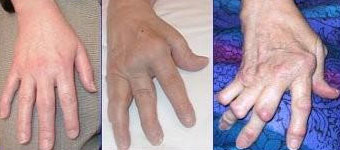Rheumatism
![]()
This article or section needs revision. More details should be given on the discussion page. Please help improve it, and then remove this tag.
![]()
This article or subsequent section is not sufficiently supported by evidence (e.g., anecdotal evidence). Information without sufficient evidence may be removed in the near future. Please help Wikipedia by researching the information and adding good supporting evidence.
Rheumatism (ancient Greek ῥεῦμα rheuma, German 'Strömung', 'Fluss', 'Fließen') or rheumatism, also rheumatic disease, refers to complaints of the musculoskeletal system with flowing, tearing and pulling pain, which are often accompanied by functional restriction. The medically correct term for rheumatism is "rheumatic disease".

Hands with chronic polyarthritis (cP)
History
Early attempts to treat people suffering from rheumatism were made in the 7th century BC in Mesopotamia (by the Assyrian king Asarhaddon) with liquorice, massages and diaphoretic remedies (Asarhaddon's physician, Arad-Nana, diagnosed his employer with an inflammation localised in the head, hands and feet, and recommended removing the supposed focus of the disease, the (decayed) teeth).
Hippocrates had already described symptoms of diseases such as rheumatic fever and distinguished acute articular rheumatism or inflammatory joint disease (arthritis) from gout (podagra).
The term "rheumatism" originated in ancient humoral pathology in connection with the "flow of bad juices" and was later transferred to diseases with flowing, tearing pains in joints, tendons and muscles.
The traditional terms rheumatism and rheumatism were coined with the Liber de Rheumatismo et Pleuritide dorsali (completed 1591, published 1642) by Guillaume de Baillou (1538-1616). He believed, according to the doctrine of the humors of the time (humoral pathology), that cold "mucus" flowed down from the brain to the extremities and caused the corresponding complaints, but for the first time (in contrast to the Corpus Hippocraticum and Galenos) distinguished the terms rheumatism and catarrh as well as the clinical pictures of gout, localized arthritis and general rheumatism.
In the 16th century, Paracelsus called rheumatic conditions "tartaric" diseases, derived from tartarus (wine tartar), since the pain-causing harmful substances are said to be deposited in the body like in a wine cask. In the 17th century, the English physician Thomas Sydenham attributed rheumatism to an inflammation of the blood. The first rheumatoid factor was discovered by Erik Waaler in 1939 by chance during the syphilis diagnosis (by means of a complement-consuming test) of a patient who also suffered from chronic polyarthritis.
The first significant rheumatism remedies were gold preparations against chronic polyarthritis and the cholchicine-containing meadow saffron, which was brought from Asia to Byzantium in the 5th century and was later supplemented with allopurinol (still used today) against gout. For chronic polyarthritis, cortisone was first used in 1948, and later chloroquine and D-penicillamine. Towards the end of the 19th century, salicylic acid contained in the bark of willows (Salix species) was used for the treatment of rheumatic fever (however, willow bark had already been used as a fever and rheumatism remedy before), before acetylsalicylic acid became the standard remedy used for this purpose around 1900 (in 1961, indometacin then came onto the market).
Division
The rheumatic spectrum includes very different clinical pictures, which are divided into four main groups according to their cause. Within these groups, a further subdivision is made. Currently, the following classification scheme applies:
- Inflammatory rheumatic diseases (autoimmune):
- Rheumatoid arthritis (chronic polyarthritis)
- rheumaticfever (also called acute rheumatism of the joints, polyarthritis rheumatica acuta and rheumatism acutus verus) has been clearly distinguished from this since 1953.
- Juvenile idiopathic arthritis
- Spondylarthritides
- Ankylosing spondylitis (Bekhterev's disease)
- Psoriatic Arthritis
- Enteropathic arthritis (associated with intestinal diseases such as ulcerative colitis)
- Reactive arthritis
- undifferentiated spondyloarthritis
- Collagenoses (connective tissue diseases):
- lupus erythematosus
- Systemic sclerosis
- Sjögren's Syndrome
- Polymyositis and dermatomyositis
- Mixed Collagenosis
- Vasculitides (diseases with vascular inflammation)
- polymyalgia rheumatica
- Degenerative ("wear-related") rheumatic diseases
- Arthroses
- Tendonitis
- Metabolic disorders associated with rheumatic complaints
- Gout and other crystal deposition diseases
- Hemochromatosis (iron metabolism disorder)
- Rheumatic non-inflammatory diseases of the soft tissues with symptoms such as pain in the musculature and tendons
- Fibromyalgia (non-inflammatory soft tissue rheumatism, "soft tissue rheumatism")
International classification
The "International Classification of Diseases of the Musculoskeletal System and Connective Tissue (ICD-10-GM, 2005)" now distinguishes between about 200 and 400 individual diseases, which differ greatly in their symptoms, course and prognosis. Therefore, the diseases of the rheumatic spectrum are difficult to survey and to diagnose - "What one cannot explain, one likes to see as rheumatism [...]".
Questions and Answers
Q: What is rheumatism?
A: Rheumatism is a general medical term used to describe various problems that can affect different parts of the body including the heart, bones, joints, kidney, skin and lungs.
Q: What is the study of rheumatism called?
A: The study of rheumatism is called rheumatology.
Q: Can rheumatism affect the heart?
A: Yes, rheumatism can affect the heart along with other organs and body parts.
Q: Does rheumatism affect only joints?
A: No, rheumatism affects various body parts including joints, bones, heart, kidney, skin and lungs.
Q: Can rheumatism be treated?
A: Yes, some types of rheumatism can be treated with medications, lifestyle changes and therapy, depending on the specific condition and its severity.
Q: What are the symptoms of rheumatism?
A: The symptoms of rheumatism can vary depending on the specific condition and may include joint pain, stiffness, swelling, fatigue, fever and skin rash.
Q: Who should be consulted if one suspects they have rheumatism?
A: If one suspects they have rheumatism, they should consult a rheumatologist or their primary care physician who can refer them to a specialist for diagnosis and treatment.
Search within the encyclopedia